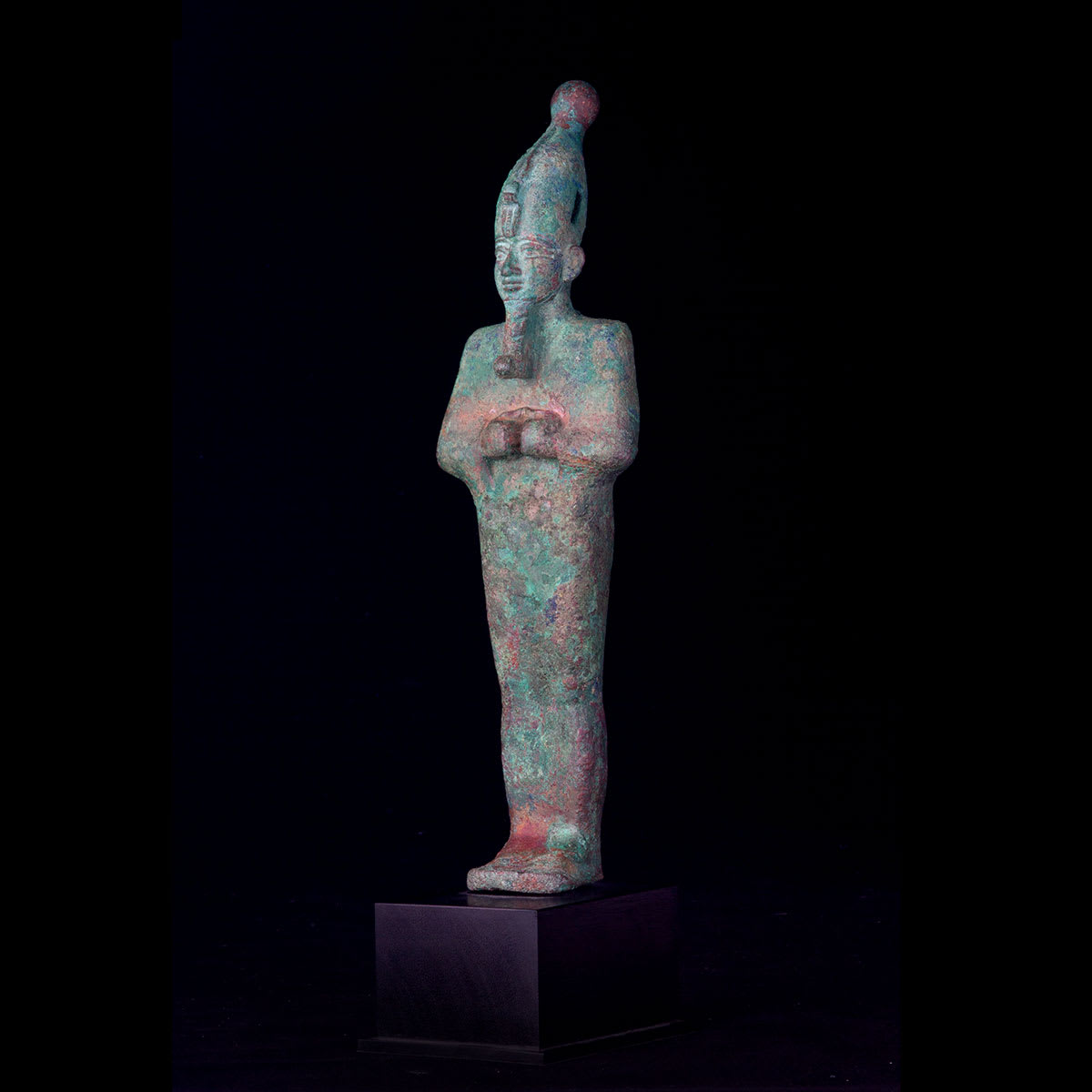Egyptian Bronze Figure of Osiris, 1000 BCE - 650 BCE
Bronze
height 26.7 cm
height 10 1/2 in
height 10 1/2 in
LO.1235
Further images
This remarkably large image of Osiris, Lord of the Westerners, depicts the god in his characteristically tightly-fitting costume which is meant to recall mummy bandages tightly wrapped around the body...
This remarkably large image of Osiris, Lord of the Westerners, depicts the god in his characteristically tightly-fitting costume which is meant to recall mummy bandages tightly wrapped around the body in order to reveal its forms beneath. Both of the god’s fisted hands protrude from beneath these bandages which are placed on his abdomen with their knuckles touching. These hands originally held the crook and flail, traditional agricultural implements with which Osiris was associated. His accessories include a plaited false beard with a curved end and the tall, White Crown fronted by a uraeus, the body of which snakes its way along the front. The hollow eye sockets were, apparently, originally inlaid.
Our statuette is in a remarkably excellent state of preservation and, to judge from its large size and style, can be dated to the Third Intermediate Period. This was an epoch during Egypt’s long history when the art of casting statuettes in bronze reach an apogee of technical perfection. Never before nor after were the ancient Egyptians to cast such technically accomplished, large scale metal sculptures. Their proficiency was so-well regarded that the ancient Greeks adopted the technology of casting bronze in the lost wax method from the Egyptians during the very period in which our example was cast. This was the period as well in which the cult of Osiris, as the consort of the goddess Isis, likewise rose to prominence. Sanctuaries dedicated to his honor at Karnak such as the Lake Edifice of Taharqa and the Temple of Osiris-Heka-Djed are still tangible reminders of the prominence of his cult during this time.
References:
Robert Steven Bianchi, “Egyptian Metal Statuary of the Third Intermediate Period (Circa 1070-656 BC), from Its Egyptian Antecedents to Its Samian Examples,” in The J. Paul Getty Museum, Small Bronze Sculptures of the Ancient World (Malibu 1990), pages 61-84.
Our statuette is in a remarkably excellent state of preservation and, to judge from its large size and style, can be dated to the Third Intermediate Period. This was an epoch during Egypt’s long history when the art of casting statuettes in bronze reach an apogee of technical perfection. Never before nor after were the ancient Egyptians to cast such technically accomplished, large scale metal sculptures. Their proficiency was so-well regarded that the ancient Greeks adopted the technology of casting bronze in the lost wax method from the Egyptians during the very period in which our example was cast. This was the period as well in which the cult of Osiris, as the consort of the goddess Isis, likewise rose to prominence. Sanctuaries dedicated to his honor at Karnak such as the Lake Edifice of Taharqa and the Temple of Osiris-Heka-Djed are still tangible reminders of the prominence of his cult during this time.
References:
Robert Steven Bianchi, “Egyptian Metal Statuary of the Third Intermediate Period (Circa 1070-656 BC), from Its Egyptian Antecedents to Its Samian Examples,” in The J. Paul Getty Museum, Small Bronze Sculptures of the Ancient World (Malibu 1990), pages 61-84.







